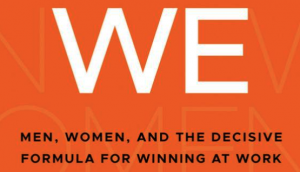I’m thrilled to announce the publication of a new book by my friend and colleague, Rania Anderson. WE: Men, Women and the Decisive Formula for Winning at Work, published by Wiley, is a major contribution to helping men and women succeed in our new economy. As companies increasingly rely on men and women to work well together, improved performance depends on men and women leading together. This book offers a simple, yet thorough blueprint for doing so.

As Rania explained to me over coffee, the impetus for writing the book came from men, who, while she was working in large international organizations, stopped her in the hall and told her “I want to learn how to collaborate better with my female colleagues. All the training is about helping women. What about helping us men?” A lightbulb went off. Rania turned her attention to researching and developing a methodology to do just that.
Her argument is compelling. Consider just a few pieces of the data she presents:
- If women were to play an identical role in labor markets to that of men, as much as $28 trillion or 26% could be added to global annual GDP by 2025 (“A CEO’s Guide to Gender Equality”; McKinsey, November 2015)
- Gender-balanced leadership leads to better, all-around performance. Companies with more women executives have greater focus on corporate governance, corporate responsibility and talent. (“About Women. Fast Forward”. -EY.com)
- Companies with more women leaders have higher net revenue margins and a higher return on equity. For profitable companies a move from 1% to 3% female leaders is associated with a 15% increase in net revenue margin. Companies with 50% women in senior operating roles show a 19% higher rate of return on equity on average. (Paradigm for Parity, “Inequality in Corporate Leadership.”)
Hopefully by now all leaders care enough to be curious. Rania’s 4.0 framework offers the antidote to complexity. There are four specific categories of behavior that will make the difference:
- Eliminate
- Expand
- Encourage
- Engage
As leaders learn to eliminate workplace practices that negatively impact any group, including comments, conduct, or compensation structures, they clear the stage to expand what’s already working.
As leaders expand their search for qualified women to fill roles, they consciously explore how they recruit, interview and select key leaders to include women. This fills the pipeline with qualified women.
As leaders encourage men and women to ensure women are sponsored adequately, that there are processes in place for them to be offered the same challenges and development opportunties as men, that their accomplishments are recognized and visible, and that those who are high performing are promoted at the same rate as male colleagues.
As leaders engage, women’s initiatives have male leader sponsorship, and that men regularly participate in initiatives that help women.
Men who lead and engage deserve to have the invaluable information in this book. The simple action steps are precise and aimed at getting results, taking the guesswork out of gender equality in the workplace.

